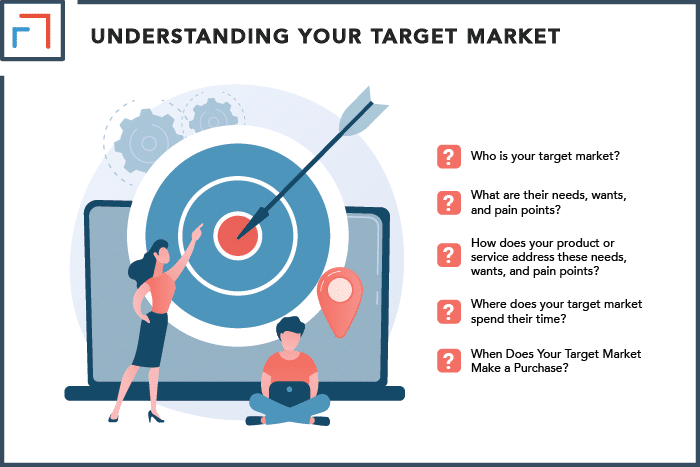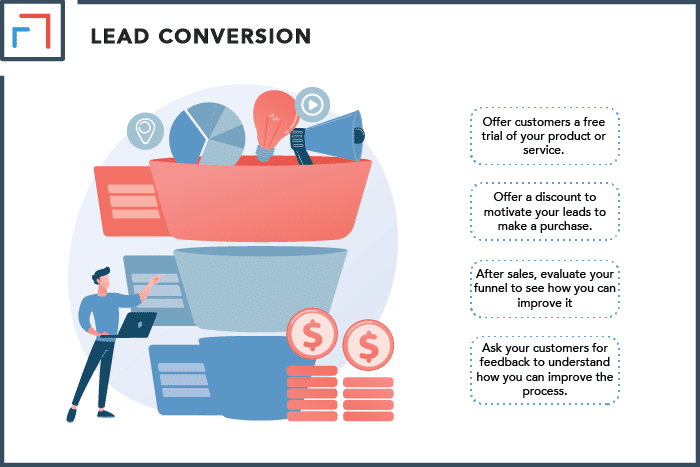Sales funnels are important because they help businesses structure their sales process and track conversions. If they have a sales funnel in place, businesses can quickly identify which sales processes are working and which ones need improvement.
To create a basic sales funnel, you should identify your target audience and develop a landing page. After that, drive traffic to the landing page and nurture the audience. Lastly, plan to convert the audience to customers through offers or discounts and retain them for future purchases.
If you want to create a sales funnel for your business but don’t know where to start, we’ve got you covered. This article will show you how to create a sales funnel from scratch and give you a template to build from.
How to Build a Simple Sales Funnel?
There is a close correlation between the stages of a sales funnel and the steps in a buyer’s journey.
Therefore, you should create a sales funnel that can target clients in each step.
Step 1: Understand Your Target Market
Trying to target everyone is like trying to catch every fish in the ocean. You’ll spread yourself too thin and won’t get a lot of return on investment.
This is why the first step is all about doing your research and understanding your target market’s needs, wants, and pain points.
To understand your target market, you should ask these questions:
Who is your target market?
If your product or service doesn’t have a specific audience, it will probably flop.
You can use competitor analysis tools like SEMrush, Ubersuggest, and Moz to identify your target market.
These tools can help you analyze your competitors’ performance and identify your audience.
You should also understand the demographic information of your target market. This includes information like age, gender, location, and income.
What are their needs, wants, and pain points?
Your target market’s needs, wants, and pain points will be the foundation of your sales funnel.
You need to understand what they want before you can offer them a solution.
How does your product or service address these needs, wants, and pain points?
Your product or service should offer an appealing solution to your target market.
You can use things like surveys, interviews, and focus groups to understand your audience better.
You can also look at social media comments and reviews to get an idea of their needs.
Where does your target market spend their time?
This question will help you determine where to focus your marketing efforts.
For example, if your target market spends most of their time on social media, then that’s where you should be marketing your product or service.
You can use Google Analytics to find out where your target market spends their time.
In addition, the tool can analyze your landing page/website performance across many different platforms.
When Does Your Target Market Make a Purchase?
This question will help you determine the best time to make an offer.
If your target market is more likely to purchase during the holiday season, then that’s when you should be making the majority of your offers.
You can use Google Trends to determine when certain search terms are most popular.
This will give you an idea of when your target market is more likely to make a purchase.
Apart from that, you can see the countries and regions where relevant search terms are common.

Step 2: Traffic Generation
You can have the best product or service in the world, but if no one knows about it, you’re not going to make any sales.
At this point, you should create a landing page for your sales funnel. This is the page where people will be redirected after clicking your ads or links.
Your landing page should:
- Include a headline and subheading that captures attention
- Have a strong call to action
- Be free of distractions like pop-ups, sidebars, and navigation menus
- Include a form to capture email addresses
- Include social proof (like testimonials or customer reviews)
Once you’ve created your landing page, it’s time to drive traffic to it. Traffic generation is an essential step in creating a sales funnel.
WordPress, Wix, and ClickFunnels are some of the most popular tools where you can create your landing page quickly.
You always need to find ways to get people to visit your website.
There are two types of traffic:
- Organic traffic: Generated through SEO or content marketing.
- Paid traffic: Generated through paid advertising.
The best way to generate traffic is to use a mixture of organic and paid methods. This will help you reach your target market more effectively.
After understanding your audience, you know who to target and where you can find them.
Step 3: Nurture the Traffic
The goal at this stage is to turn your website visitors into leads.
A lead is a person who has shown an interest in your product or service by giving you their contact information.
The best way to nurture your leads is to create content that will help them progress along the buyer’s journey.
For example, if you’re selling a new skincare product, you might want to create blog posts that teach your audience about the benefits of using the product.
You can also use email marketing to nurture your leads. With this, you can send them helpful information or discounts on your products or services.
Some useful tools for email marketing include Mailchimp, HubSpot, and Constant Contact.
The tools will help you track the performance of your emails (click-through rate, open rate, growth, and others).
You can also use lead magnets to get your target audience’s contacts.
A lead magnet is an incentive you offer in exchange for someone’s contact information. It can be a:
- Free e-book
- Report
- Webinar
- Template
The goal of the lead magnet is to get people to sign up for your email list. You can encourage purchases once they’re on your list.
Step 4: Lead Conversion
The final step in creating a sales funnel is to convert your leads into customers. This is where you actually make a sale.
Although conversion is essential, your effectiveness depends on how well you manage the other steps in your sales funnel.
The best way to convert your leads into customers is to offer them a free trial of your product or service.
This allows them to experience the benefits of using your product without actually purchasing it.
You can also offer a discount. This is a great way to motivate your leads to take action and make a purchase.
The process often ends here. After making sales, you should evaluate your funnel to see how you can improve it.
You can use tools like Google Analytics or Crazy Egg to track your sales funnel and see where people are dropping off.
Some essential metrics to check are:
- Conversion rate: The percentage of people who take the desired action.
- Bounce rate: The percentage of people who leave your website after viewing only one page.
- Average time on page: The time people spend on each page of your website.
- Exit rate: The percentage of people who leave your website from a specific page.
You can also use A/B testing to improve your sales funnel. This involves testing two different versions of a web page to see which one performs better.
You can test anything on your pages, such as the headline, call to action, or images. You should also ask your customers for feedback.
This will help you understand what they’re looking for and how you can improve the process.
Finally, keep in touch with your customers so you can retain their loyalty and continue to offer them promotions.
If they buy once, they’re likely to buy again.

Conclusion
Creating a sales funnel is an essential part of any business. By following these steps, you can create a sales funnel from scratch.
Remember to focus on your target market, generate traffic, nurture your leads, and convert them into customers.
With a bit of time and effort, you’ll be on your way to success.
